Temple Investigations
●Dalongdong Bao An Temple
The Dalongdong Bao An Temple, a national historic site with a history of more than 250 years, is dedicated to the deity Baosheng Emperor, a real person from the Song dynasty named Wu Ben, from Tongan County, Fujian Province. After studying medicine in various places, he returned to his hometown and practiced medicine in order to help people, and was revered as the god of medicine by the villagers because of his superb medical skills. There is a legend that “the dragon’s eye and the tiger’s throat are cured” by the Baosheng Emperor. Legend has it that after his ascension to heaven, the Baosheng Emperor would often appear as a spirit to rid the people of evil and cure diseases. Therefore, emperor Gaozong of Song built a temple for him in 1151. The temple was built by the people of Tongan County in the Qing dynasty. After years of construction and renovation, it has formed a magnificent layout with 11 rooms in width, three halls in depth, and a bell and drum tower on the left and right, which is a model of a three-hall temple.
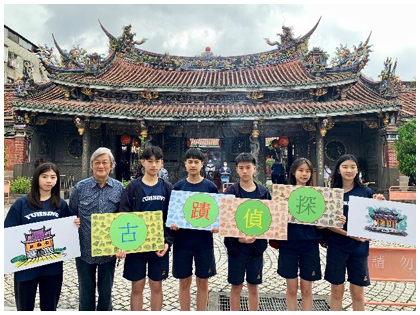
The famous left and right confrontational construction method adopted
in Bao An Temple
Source: Detective of Historic sites
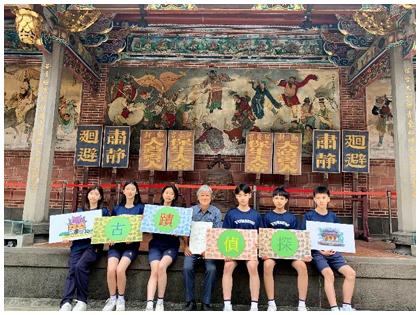
The Exquisite Painted Mural in Bao An Temple
Source: Detective of Historic sites
The 1917 major renovation of Bao An Temple was done by two masters, Chen Ying-Bin and Guo Ta, each working on one half of the temple’s main hall. Each of the masters showcased his own unique skills and techniques in the highly refined woodwork. This left and right confrontational construction method adopted is said to be a famous event in the artisan circle. It is famous for its decorative art in temples. The temple also houses many precious artworks of significant Taiwanese contemporary art masters, including the wooden works of Chen Ying-Bin and Guo Ta, the painted murals of Pan Li-Shui, and the cochin pottery works of Hong Kun-Fu. The fine architecture and diverse decorations make the temple a building of great artistic value, leaving a historical testimony for the ancestors of Dalongdong.
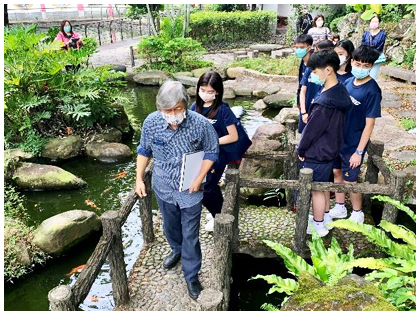
Professor Li led the students to walk the small bridge
with the swastika in Lin Sheng Yuan
Source: Detective of Historic sites
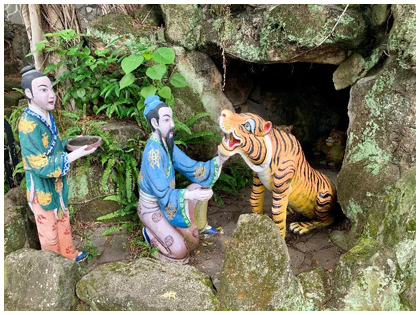
The legendary sculpture of " The tiger’s throat are cured "
in Lin Sheng Yuan
Source: Detective of Historic sites
Six of us had the honor to be led by Professor Li Chien-Lang to visit the Bao An Temple in Dalongdong, which represents the Taoism of Laozi and Zhuangzi, and the Confucian Temple in Taipei, which represents Confucianism. We first visited the garden of Bao An Temple (Lin Sheng Yuan). The garden is designed in accordance with Laozi and Zhuangzi concept of following nature, and many asymmetrical designs can be seen. For instance, irregularly shaped pools and zigzagging small swastika bridges are for the purpose of staying on the water surface more, diverting water and borrowing energy for health preservation (a way to borrow qi in Taoism). The cave in the Heavenly Blessing is full of ideas born out of the trend. In contrast to the semi-circular symmetrical arch bridge in the Confucius Temple across the street, the style is very different. Professor Li also shared that he has been to Qingjiao in Fujian Province, where there are various exotic flowers in the mountains. It is said that during his lifetime, Emperor Baosheng often went to the mountains to collect various plants for medicine, cure people’s diseases, and also often eliminate disasters for people. He was admired by the people and worshiped as a god after his death. There is a hole in a rock on Qingjiao Mountain and local residents widely rumor that this hole is the trace left by Emperor Baosheng grinding medicine. The professor also introduced the legendary sculptures of Emperor Baosheng in the garden, such as “Healing Tiger’s Throat”, “Brightening Dragon’s eye”, and “Diagnosing Pulse with Silk Thread”, which are so vivid that people can appreciate the scenery and learn about the miracle of Emperor Baosheng’s compassion to help the world.
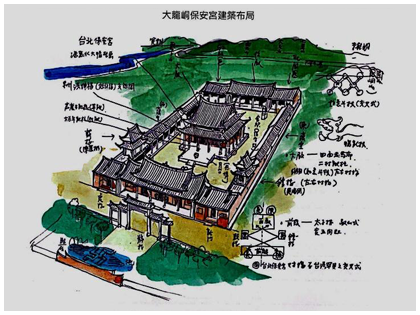
The architectural layout of the Bao An Temple
Source: Professor Li Chien-Lang
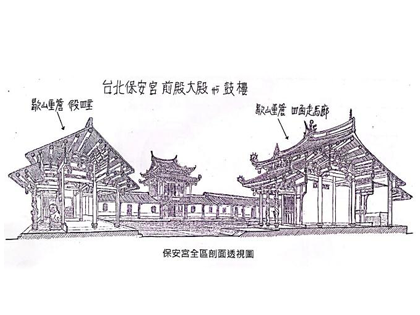
The sectional perspective view of the Bao An Temple
Source: Professor Li Chien-Lang
Then Professor Li took us to visit the Bao An Temple. The wood carvings, stone decorations, and statues of the deities were all exquisitely carved, making the whole temple look like a piece of religious architectural art. Because of the left and right confrontational construction method adopted in the renovation project, bilateral asymmetry can be seen everywhere, such as different themes and styles bilaterally, and even the different shapes and numbers of columns between the bell tower and the drum tower. Moreover, the pairing is a rare crossover pattern in Taiwan after careful observation and scrutiny. Another highlight is the seven painted murals on the walls of the corridor surrounding the main hall by the famous Tainan craftsman Pan Li-Shui. In order to maintain these seven paintings, the temple especially hired experts from abroad, which shows their preciousness.
From 1995 to 2002, the Bao An Temple completed a large-scale restoration project in these seven years. It is the first non-government-led and fund-raising historic site conservation project in Taiwan. The management model adopted was the old system of master craftsman cooperation model. The renovation project used traditional materials and techniques, combined with scientific non-destructive inspection methods, supplemented by traditional visual percussion method to detect damage to historic wood and select new materials, so that while restoring the ancient structures, it also improves ventilation, lighting, fire protection, humidity control, etc. The goal is to restore as much as possible the old appearance after the last large-scale renovation in 1917, and avoid “historical sites becoming new ones”. It was awarded the “2003 Asia-Pacific Cultural Asset Preservation Award” in the UNESCO Asia-Pacific Cultural Heritage Conservation Competition and was designated as a national historic site in 2018, making it a role model of historic site restoration in Taiwan. The six of us are like historic site detectives. Under the leadership of Professor Li, we went deep into the Bao An Temple, a precious historical site that combines artistic achievements and stable and peaceful religious power. During our visit, we were certainly impressed by its friendly environment and spirit of unity and common prosperity.
- https://www.baoan.org.tw/index.php
- https://www.taiwan.net.tw/m1.aspx?sNo=0001090&id=2178
- https://www.taiwangods.com/html/landscape/1_0011.aspx?i=12
- https://www.ylib.com/author/lan/lan_s7.htm
- Li Chien-Lang. Architecture and Decorative Art of Dalongdong Bao An Temple. 1997.
- Li Chien-Lang, Yu Yiping. The Ultimate Guide to Historic Sites of Taiwan. 1999. Yuan-Liou Publishing Co., Ltd.
- Li Chien-Lang. Into the Heart of Craftsmanship. 2019. Yuan-Liou Publishing Co., Ltd.
●Taipei Confucius Temple
Taipei Confucius Temple is located in the Dalongdong district, together with Dalong Elementary School and Bao An Temple, forming the Dalongdong Cultural Area. The Temple enshrines the tablets of Confucius, sages, and philosophers. In 1925, the gentry of Taipei advocated reconstructing Taipei Confucius Temple and hired a famous craftsman, Wang Yi-Shun, from Quanzhou (in Fujian Province) as the chief architect to design and construct it. Its layout followed the traditional Confucius Temple and also adopted Minnan architectural style. Taipei Confucius Temple is magnificent and symmetrical along with the Y-axis. The main buildings include Wanren Temple Walls, the Pan Pond, Lingxing Gate, Yi Gate, and Dacheng Hall.

Source: Detective of Historic sites
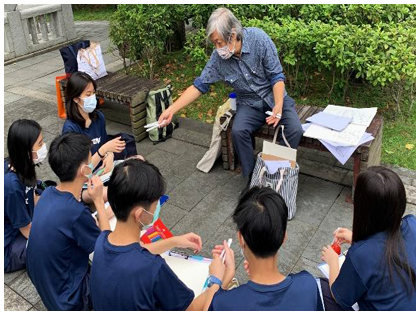
Source: Detective of Historic sites
The on-site visit to Taipei Confucius Temple is different from previous visiting activities. Professor Li led us to use architectural hand-drawings to observe the architecture of the temple and experience its beauty. Just like a detective of historic sites, we followed Professor Li to weave through the buildings of the temple. Our observation focus includes the arch bridge in the middle of the Pan Pond, the stone drums of the Lingxing Gate, the hornless dragon-carved windows of the Yi Gate, the cloud dragon on the imperial road, the coiled dragon pillars in front of the Dacheng Hall, and the hornless dragons carved on the stone cabinet inside the Dacheng Hall. These are classical architectural decorations, considered to be masterpieces, with delicate techniques and artistic value.
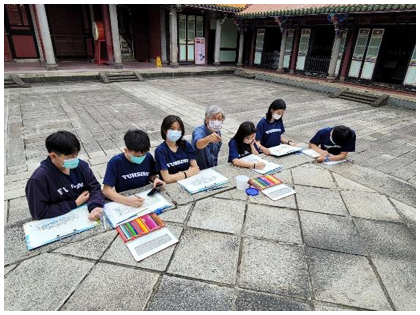
Source: Detective of Historic sites
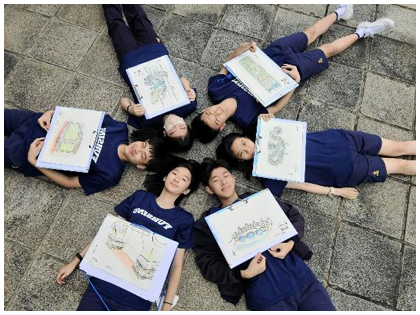
Source: Detective of Historic sites
During the process of architectural hand-drawing, we found that Taipei Confucius Temple is different from other temples by the lack of gorgeous decorations. For example, stone lions are missing from the entrance, and no inscriptions can be found on the temple columns, doors, and windows. Its style is simple and solemn. We also found that there is a tiny difference in the thickness of the coiled dragon on the pillars in front of the Dacheng Hall. Professor Li explained that after a lot of years, the temple is gradually weathering, which is necessary to be repaired by craftsmen. To sum up, historic sites represent the evolution of history and are worthy to be cherished. Only through collaboration to restore and preserve the historic sites can we truly sustain the history, as well as the memory, behind the ancient buildings. It is an environmentally friendly action to make classical and modern buildings co-exist and prosper.

Source: Detective of Historic sites
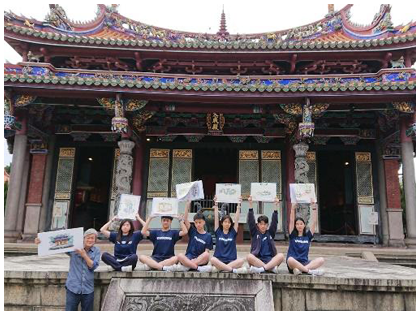
Source: Detective of Historic sites
- https://tct.gov.taipei/
Taipei Confucius Temple Governing Board - https://www.tctcc.taipei/
Taipei Confucius Temple Confucian Culture - https://www.travel.taipei/zh-tw/attraction/details/86.
Taipei Confucius Temple, Travel in Taipei
●Yinshan Temple
On a sunny afternoon on August 28, the team members followed the footsteps of Professor Li Chien-Lang to Yinshan Temple in Tamsui. What is special about the temple is that it was eerily quiet and seemingly forlorn. When I looked up, I thought I would see Datun Mountain, which stands behind the temple. Such a scene should give the feeling of the temple being built against the mountain. Unexpectedly, there were several residential buildings directly behind the temple, which were built for the needs of urban development. Fortunately, according to the “Cultural Heritage Preservation Act”, as long as the nearby buildings are recognized as historic sites, the design drawings must be submitted for review. Details such as the height, color, etc. will be carefully evaluated. A small piece of sky was given to this ancient temple (photo 1); although it is not perfect, it is satisfactory. To elaborate on this idea, Professor Li mentioned that St. Patrick’s Church on the Fifth Avenue in New York is built in the center of the most prosperous and crowded tourist attraction. Although it seems a bit out of place at first glance, it has also become a major tourist attraction in New York. This example indicates that the combination of old and new buildings has become a global trend.
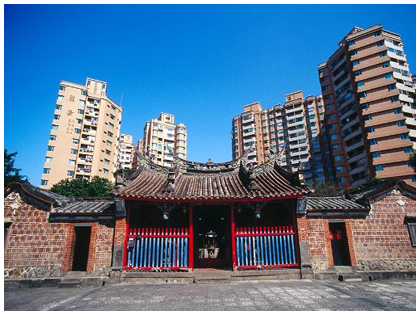
Source: Detective of Historic sites
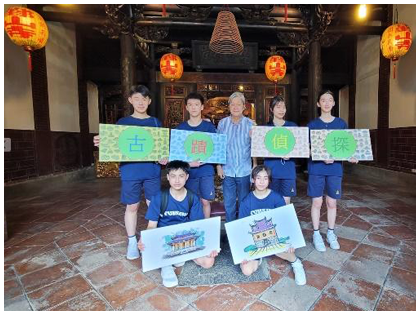
Source: Detective of Historic sites
Upon entering the temple, we did not see a statue of the Buddha nor the Bodhisattva, but that of a monk. Due to transportation needs, it is made of bamboo from the neck down, so it is called a “soft-body Buddha”. Professor Li explained that this monk from Tingzhou, Fujian Province has a profound morality and esteemed character. Legend has it that there was a fierce tiger in the mountains. The monk came forward to lobby and appease it (photo 4). When dragons appeared in the river and often capsized the boats, the monk came forward to do the same thing again, taming the disturbing wild beasts and eliminating all kinds of disasters for the local people. Although there is no basis for these oral legends, as the professor said: “Human culture is composed of legends.” In addition to the legends about this Song dynasty monk, the temple is also full of literary elements, there is a couplet created during the reign of the Daoguang Emperor in the Qing dynasty, praising this monk as a great man through the ages. Professor Li broke down sentences and analyzed them for us sentence by sentence, and told us literary knowledge such as oblique and flat tones, and upper and lower couplets. Thus, we have learned a lot regarding the history and the beauty of literature as well.
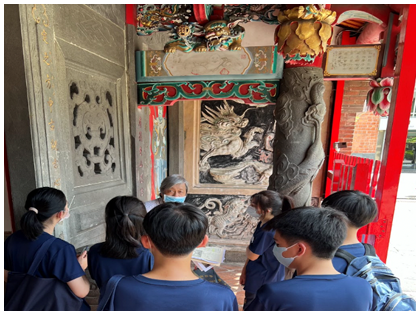
Source: Detective of Historic sites
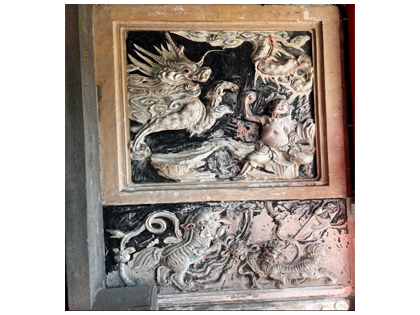
Source: Detective of Historic sites
Approaching the interior of the temple, we were excited to see the professor’s name on the inscription of the construction record (photo 5). After a closer look, we found that in the 74th year of the Republic of China (1985), Professor Li was in charge of the restoration of the temple. It was a heavy responsibility to investigate, research, and draw up a restoration plan, so he is very familiar with this Buddhist temple. He also jokingly said that it is “obligatory” for him to introduce this temple that holds a dear place in his heart. Pointing to a piece of rotten wood next to the temple, the professor said that it was rotten wood from a major renovation. The exterior restoration of the temple more than 30 years ago seemed to be vivid in his memory. And when we were observing the plaque in the temple (photo 6), we accidentally found a crack. The professor observed it for a while and said that the previous renovation only repaired the shell of the building. He will give the advice to the government that the damage should be repaired. At this moment, a sense of honor emerged spontaneously, and we realized that this is the joy of caring for historical sites and making contributions to their restoration.
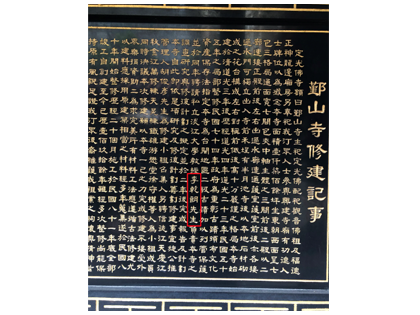
Source: Detective of Historic sites

